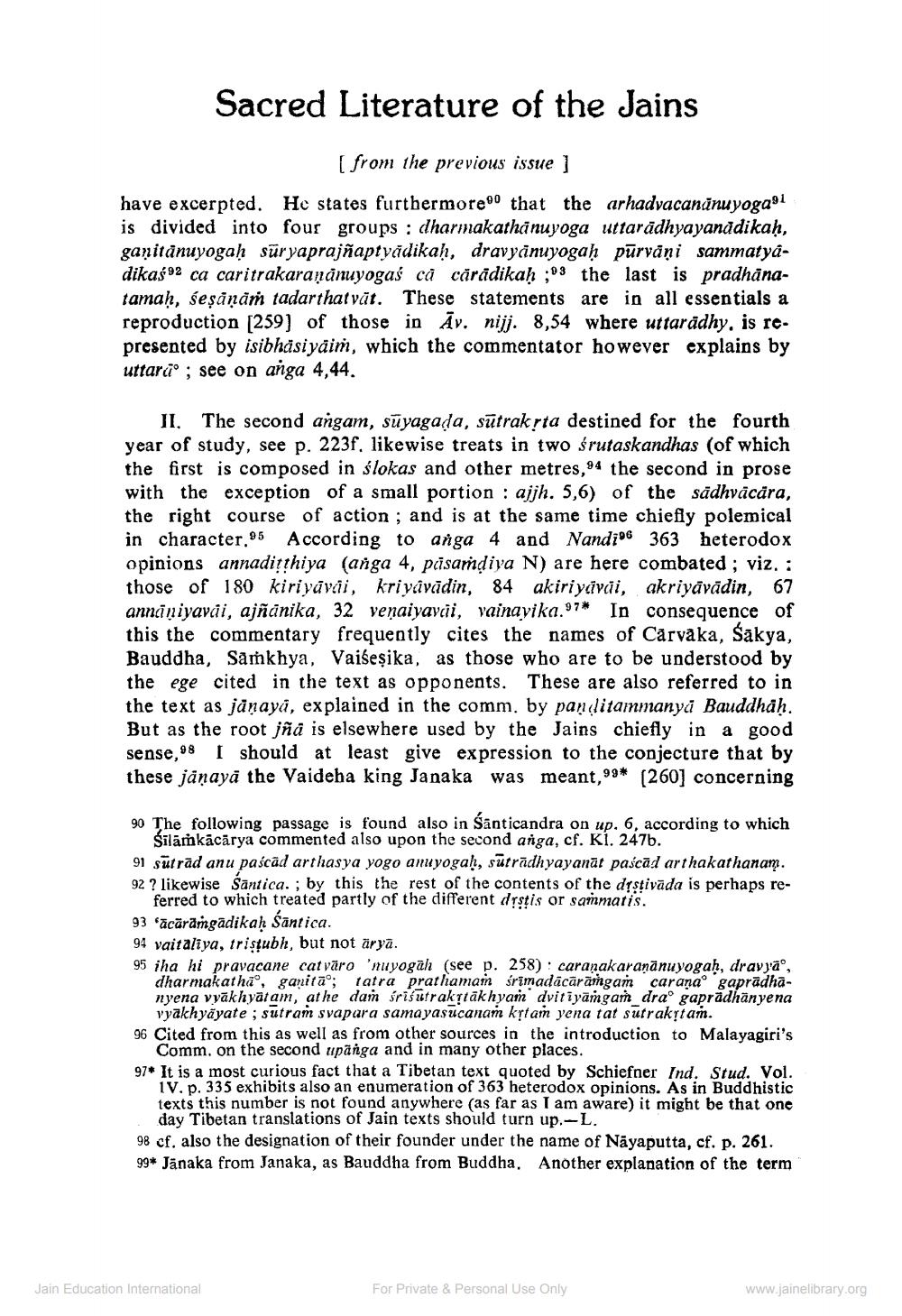Book Title: Jain Journal 1992 07 Author(s): Jain Bhawan Publication Publisher: Jain Bhawan Publication View full book textPage 6
________________ Sacred Literature of the Jains [ from the previous issue ] have excerpted. He states furthermore that the arhadvacanānuyogao1 is divided into four groups: dharmakathānuyoga uttaradhyayanādikaḥ, ganitanuyogaḥ sūryaprajñaptyādikaḥ, dravyānuyogaḥ pūrvāņi sammatyadikas 92 ca caritrakaraṇānuyogaś că cărādikaḥ;93 the last is pradhanatamaḥ, śeṣāṇāṁ tadarthatvāt. These statements are in all essentials a reproduction [259] of those in Av. nijj. 8,54 where uttaradhy, is represented by isibhäsiyaim, which the commentator however explains by uttara; see on anga 4,44. II. The second angam, suyagada, sūtrakṛta destined for the fourth year of study, see p. 223f. likewise treats in two śrutaskandhas (of which the first is composed in slokas and other metres,94 the second in prose with the exception of a small portion: ajjh. 5,6) of the sadhvācāra, the right course of action; and is at the same time chiefly polemical in character.95 According to anga 4 and Nandi 363 heterodox opinions annadiṭṭhiya (anga 4, pasaṁḍiya N) are here combated; viz. : those of 180 kiriyāvai, kriyavādin, 84 akiriyāvāi, akriyāvādin, 67 annāṇiyavāi, ajñānika, 32 veṇaiyavai, vainayika.97* In consequence of this the commentary frequently cites the names of Carvaka, Šakya, Bauddha, Samkhya, Vaiseṣika, as those who are to be understood by the ege cited in the text as opponents. These are also referred to in the text as jāṇaya, explained in the comm. by paṇḍitammanya Bauddhaḥ. But as the root jñā is elsewhere used by the Jains chiefly in a good sense, 98 I should at least give expression to the conjecture that by these jäṇaya the Vaideha king Janaka was meant," 99* [260] concerning 90 The following passage is found also in Santicandra on up. 6, according to which Silaṁkācārya commented also upon the second anga, cf. Ki. 247b. 91 sutrad anu paścãd arthasya yogo anuyogaḥ, sūtradhyayanāt paścād arthakathanam. 92? likewise Santica.; by this the rest of the contents of the dṛṣṭivada is perhaps referred to which treated partly of the different drstis or sammatis. 93 ācārāmgādikaḥ Śantica. 94 vaitaliya, tristubh, but not äryā. 95 iha hi pravacane catvāro 'nuyogah (see p. 258) caranakaraṇānuyogaḥ, dravya°, dharmakatha, ganita; tatra prathamam śrimadacaramgam carana gapradhanyena vyakhyātam, athe dam śrisutrakṛtakhyam dvitiyamgam dra gapradhanyena vyakhyāyate; sutram svapara samayasucanam kṛtam yena tat sutrakṛtam. 96 Cited from this as well as from other sources in the introduction to Malayagiri's Comm. on the second upanga and in many other places. 97* It is a most curious fact that a Tibetan text quoted by Schiefner Ind. Stud. Vol. IV. p. 335 exhibits also an enumeration of 363 heterodox opinions. As in Buddhistic texts this number is not found anywhere (as far as I am aware) it might be that one day Tibetan translations of Jain texts should turn up.-L. 98 cf. also the designation of their founder under the name of Nayaputta, cf. p. 261. 99* Janaka from Janaka, as Bauddha from Buddha. Another explanation of the term Jain Education International For Private & Personal Use Only www.jainelibrary.orgPage Navigation
1 ... 4 5 6 7 8 9 10 11 12 13 14 15 16 17 18 19 20 21 22 23 24 25 26 27 28 29 30 31 32 33 34 35 36 37 38 39 40 41 42 43 44 45 46 47 48 49 50 51 52 53 54 55 56 57 58 59 60 61 62
